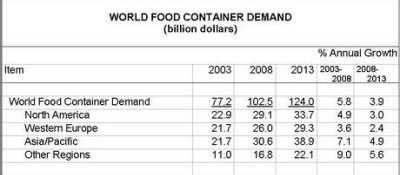
Global Demand For Food Containers To Reach $124 Billion Dollars In 2013
By Canadian Packaging Staff
General Food Containers Freedonia Group StudyWorld demand for food containers is forecast to increase 3.9 per cent per year to $124 billion in 2013. Factors contributing to rising demand include growth in global food output and trends toward convenience-oriented food options as a result of fast-paced lifestyles. Products made from biodegradable materials will post robust advances, albeit from a low base. This is due to increased pressure on packaging producers to reduce their environmental footprint. These and other trends are presented in "World Food Containers", a new study from The Freedonia Group, Inc., a Cleveland-based industry research firm.
While the U.S. is by far the world’s largest user of food containers, the most rapid increases will occur in the world’s developing regions with Asia, Latin America, Eastern Europe and the Africa/Mideast region will all outpace the global average.
Population growth and greater urbanization, industrialization trends, and expanding international trade will support advances in these regions’ generally underdeveloped packaging sectors. Rising consumer income levels and expanding middle classes will also generate robust internal demand for packaged consumer goods like processed foods, boosting food container consumption. Some of the best gains are expected in the BRIC countries of Brazil, Russia, India and China. In particular, China alone is expected to account for nearly one-quarter of global value gains in food container demand between 2008 and 2013.
To a large degree, demand for food containers will be supported by continued expansion in food production. However, great disparity in usage intensity will remain among the different regions, with the strongest growth potential existing in developing regions.
Overall, bags and pouches will remain the largest product type by a wide margin, supported by ongoing developments in high-barrier resins and value-added features such as microwaveable bags and resealable stand-up pouches. In addition, demand for bags and pouches will benefit from their favorable environmental profile, since they are often used as part of waste reduction efforts, impart storage space savings, and generally require less energy to produce and transport compared to rigid packaging.
The fastest gains are anticipated for plastic containers, based on improvements in plastic container performance and their price competitiveness. Still, metal cans will remain an important segment of the food container mix due to the economic advantages of canned items in controlling food expenditures.

Advertisement

